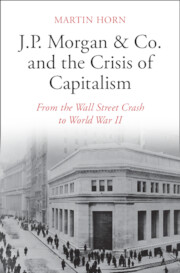Book contents
- J.P. Morgan & Co. and the Crisis of Capitalism
- J.P. Morgan & Co. and the Crisis of Capitalism
- Copyright page
- Dedication
- Contents
- Figures and Tables
- Acknowledgements
- Introduction
- 1 “The Heart of Contemporary Capitalism”
- 2 J.P. Morgan & Co. at Home and Abroad in the 1920s
- 3 The Young Plan, the Bank for International Settlements, and the Wall Street Crash, 1929–1930
- 4 “The End of the World”? The 1931 Crises
- 5 “Witchcraft”: J.P. Morgan & Co., Hoover, and the Depression in the United States, 1930–1933
- 6 “In the Storm Cellar”: J.P. Morgan & Co. and the New Deal, 1933–1936
- 7 J.P. Morgan & Co. and the Foreign Policy of the New Deal
- 8 The Coming of War and the End of the Partnership, 1937–1940
- Conclusion
- Appendices
- Bibliography
- Index
5 - “Witchcraft”: J.P. Morgan & Co., Hoover, and the Depression in the United States, 1930–1933
Published online by Cambridge University Press: 17 February 2022
- J.P. Morgan & Co. and the Crisis of Capitalism
- J.P. Morgan & Co. and the Crisis of Capitalism
- Copyright page
- Dedication
- Contents
- Figures and Tables
- Acknowledgements
- Introduction
- 1 “The Heart of Contemporary Capitalism”
- 2 J.P. Morgan & Co. at Home and Abroad in the 1920s
- 3 The Young Plan, the Bank for International Settlements, and the Wall Street Crash, 1929–1930
- 4 “The End of the World”? The 1931 Crises
- 5 “Witchcraft”: J.P. Morgan & Co., Hoover, and the Depression in the United States, 1930–1933
- 6 “In the Storm Cellar”: J.P. Morgan & Co. and the New Deal, 1933–1936
- 7 J.P. Morgan & Co. and the Foreign Policy of the New Deal
- 8 The Coming of War and the End of the Partnership, 1937–1940
- Conclusion
- Appendices
- Bibliography
- Index
Summary
This chapter examines J.P. Morgan & Co., the Hoover administration, and the progress of the Depression in the United States between 1930 and 1933. It challenges the idea that banks were bystanders as the trauma of the Great Depression unfolded. Morgan activity took several forms. The first was acting selectively to aid private institutions in trouble in 1930–31. This policy ended with the last quarter of 1931 when heavy losses weakened the Morgan bank. While 1930–33 was devastating for the bank’s operations, two periods stand out as especially harmful: the last quarter of 1931 and the first quarter of 1933. The Morgan partners pushed the Hoover administration to adopt forceful measures to respond to deflation. Leffingwell and Parker Gilbert believed that deflation was imperilling capitalism’s existence. Attempts to shift Hoover were unsuccessful, in part because of the latter’s suspicion of the Morgan bank, in part because of the incoherence of the Morgan policy prescription. By the opening months of 1933 the Morgan partners had come to accept that suspension of the gold standard was necessary to save capitalism. Yet, the chapter suggests, by Roosevelt’s inauguration neither Hoover nor Roosevelt were listening to the partners.
- Type
- Chapter
- Information
- J.P. Morgan & Co. and the Crisis of CapitalismFrom the Wall Street Crash to World War II, pp. 154 - 206Publisher: Cambridge University PressPrint publication year: 2022

